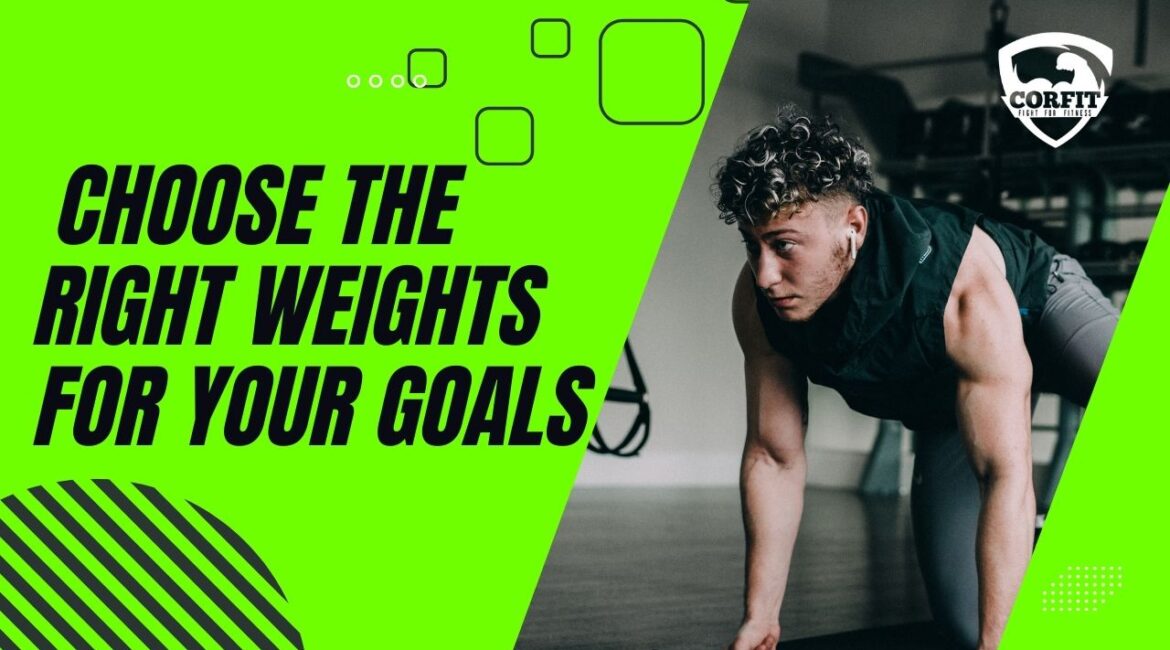Selecting the fitness Goals appropriate Perfect weight is crucial to achieving your fitness aspirations, whether you aim to build muscle, burn fat, or enhance overall physical health. The right choice of weights can improve workout efficiency, minimize injury risks, and ensure steady progress. This guide offers insights to help you determine the best weights for your unique needs.
Table of Contents
1. Define Your Fitness Objectives
Understanding your goal is the first step in selecting the proper weights:
- Muscle Growth (Hypertrophy): Use moderate to heavy weights that challenge your muscles for 8-12 repetitions per set. Strive for near failure at the end of each set.
- Strength Building: Opt for heavier weights with low repetitions (3-6 reps per set).Be sure to rest 2-5 minutes between sets for maximum recovery.
- Weight Loss and Toning: Stick to lighter weights with higher repetitions (12-15 reps per set). This combination boosts calorie burn and endurance.
- Improving Stamina: Choose very light weights and aim for 15-20+ repetitions per set to build muscular endurance.
2. Evaluate Your Current f Level
Your experience determines your starting point:
- Beginners: Begin with light weights to master form and technique before progressing.
- Intermediate: Experiment with moderate weights to push your limits while maintaining form.
- Advanced: Challenge yourself with heavy weights and advanced techniques like supersets and progressive overload.
3. Implement Progressive Overload
Progressive overload ensures continuous improvement by gradually increasing the difficulty of your workouts. Steps to apply:
- Start with a manageable weight for your desired reps.
- When the exercise becomes too easy, increase the weight by 2.5-5%.
- Monitor performance and adjust as needed.



4. Learn About Your 1-Rep Max (1RM)
Your 1RM is the heaviest weight you can lift for a single rep. Use this as a baseline for setting weight targets:
- Strength Training: 80-90% of 1RM
- Hypertrophy: 65-75% of 1RM
- Endurance: 50-60% of 1RM
5. Match Equipment to Your Needs
Different equipment serves specific purposes:
- Dumbbells: Ideal for unilateral exercises and range of motion.
- Barbells: Perfect for compound movements like squats and deadlifts.
- Kettlebells: Enhance dynamic and functional training.
- Machines: Provide stability and isolate muscle groups effectively.
6. Select Weights Based on Exercise Type
- Compound Movements: Use heavier weights for exercises like squats and deadlifts.
- Isolation Movements: Opt for lighter weights for targeted exercises like bicep curls.
- Cardio-Based Workouts: Choose light weights to maintain speed and proper form.
7. Tune Into Your Body’s Signals
Recognizing the appropriate weight:
- Too Light: Exercise feels effortless, with no fatigue.
- Ideal Weight: Last few reps are tough but achievable.
- Too Heavy: Compromised form or inability to complete reps.
8. Prioritize Rest and Recovery
Rest is vital for progress and avoiding injuries:
- Hypertrophy: 30-90 seconds between sets
- Strength: 2-5 minutes between sets
- Schedule weekly rest days
9. Monitor and Record Your Progress
Keep track of:
- Weights lifted
- Repetitions completed
- Adjustments made
Consistency in tracking helps identify areas for improvement.
10. Avoid Common Mistakes
Prevent these pitfalls:
- Skipping Warm-Ups: Warm up with light weights and dynamic stretches.
- Neglecting Form: Maintain proper technique to prevent injuries.
- Overloading Too Quickly: Progress gradually to ensure safety.
11. Sample Weight Recommendations
a) For Hypertrophy:
- Bench Press: 8-12 reps with moderate weights
- Deadlifts: 6-10 reps with heavy weights
b) For Weight Loss:
- Weighted Lunges: 12-15 reps
- Kettlebell Swings: 15-20 reps
c) For Strength:
- Squats: 3-6 reps with maximum weight
12. Combine Nutrition and Hydration
Nutrition supports workout outcomes:
- Protein: Repairs muscles.
- Carbs: Fuels exercise.
- Water: Prevents dehydration.
13. Seek Expert Advice
A personal trainer can:
- Evaluate form
- Suggest appropriate weights
- Customize a plan for your goals
14. FAQs About Weight Selection
Q1: How often should weights be increased?
Increase every 2-4 weeks as exercises become easier.
Q2: Can all exercises use the same weights?
No, weights should vary by exercise type and muscle group.
Q3: Is weightlifting good for weight loss?
Yes, it helps preserve muscle and boosts metabolism.
15. Final Takeaway
Choosing the right weights is essential for effective training. Align your choices with your goals, listen to your body, and gradually progress. Pair your efforts with proper nutrition, rest, and consistency for long-term success. Ready to start your fitness journey? Visit corfit gym for expert advice and tools.

